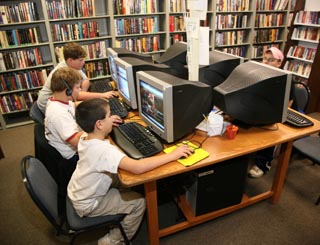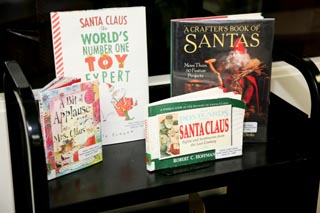
Part II: Libraries become destinations and gathering places As the library patron evolves and technology compounds the person's tasks and training, the librarian needs to be more adaptable than ever before. In addition to the mastery of the Dewey Decimal system, library directors and staff act as the buyers of fresh and weeders of outdated stock, tasks that themselves require countless hours of reading: library journals, bestseller lists, publisher magazines, and other data. Library administrators are research professionals and must be prepared to handle a patron's inquiry about a book, an Internet website or a crafts program at any time, any day. It is all the more remarkable, then, that these masters of multitasking continue to provide sincere assistance on an individual basis, often remembering not only the name of a patron, but his or her favorite author as well. "Our small town rural quality endures," says Donna Haire, director of the Newman Riga Library, "And some folks like that ambiance." From Hamlin to Holley, Chili to Parma, patron surveys almost unanimously cite staff as the greatest library asset, and friendly and competent service is what brings many of them back time and again. "Libraries are also becoming a place," says Sandra Shaw. "There are too few places for people to congregate except for a library, so we find ourselves hosting programs and sponsoring groups who meet in the library just to talk and be with other people." As proof of its commitment to a public with needs unanswered, the Seymour Library in Brockport recently held an open house to introduce its community to their resources and programs for homeschoolers. Chili, Greece, Parma and Webster have also joined in a collective effort to address the homeschooling crowd, backed by the support of the Parent and Child Library Services grant from the New York State Library and the New York State Education Department. In addition to group events, materials and staff counseling, the four branches put together a pamphlet listing over 60 available titles on the practice, art and foibles of homeschooling, from 100 Top Picks for Homeschool Curriculum by Cathy Duffy, to If I'm Diapering a Watermelon, Then Where'd I Leave the Baby? by Carol Barnier. At the Holley Community Free Library, a member of the NIOGA Library System (including Niagara, Orleans and Genesee Counties), homeschooling is fast becoming a top priority, according to Sandra Shaw. There are about 50 homeschool students in the Holley School District, where total enrollment is about 1,300. Without the centralization of resources that would be available to their children if they attended a local institution, parents of homeschoolers greatly benefit from the support of their local library. As a result of their place apart from the professional schooling of a public institution, parents of homeschoolers must be much more involved in the education of their children. And as teachers, they must be versed not only in curriculum, but in pedagogy, administration and discipline, as well. It is no surprise, then, that at Holley and Chili, the library staff often take suggestions from parents to better address the needs of homeschoolers, proving yet again that the library is adapting wholeheartedly to its role as community center and is more than willing to bridge the gaps thought to be left open. Library of the 21st century Topics for the institute included iPods, "wikis" (interactive, do-it-yourself websites that encourage their browsers to become their authors as well), and Library 2.0. On the MCLS blog site devoted to the institute (http://mcls.wordpress.com/), Rochester Public Library Assistant Director David Creek writes about the impact of a digital community on library service in a post entitled: "Millennials, Boomers and Libraries." Through such interactive, user-defined technologies as Wikipedia (the free, community-run, Internet encyclopedia), writes Creek, "The community becomes the expert, and the best ideas are by definition those adopted by the community. If this is true, the library will be one of many partners adding its voice to a chorus of digital users organized around a particular interest." The notion of library as community center becomes amplified, literally reaches beyond its walls, connecting town and village to city, country and globe, mirroring the developments already seen in commerce and culture. Creek believes that libraries are in a period of transition, parallel to the generational shift from the tech-phobic to the tech-literate, though he is unsure what results the transition will yield. "How far ahead of this can we get," Creek asks, "and still honor the reality that many of our patrons are not part of and never will be part of this world - and more importantly, value different priorities?" Take a tour of the towns and you are likely to find that this question is daily addressed at most libraries, and, in most cases, resolved. At the Ogden Farmers' Library, for example, the concept of a generational gap is a non-sequitur at best. In a single visit, you can write content on Wikipedia, watch a slapstick animation on YouTube (a website that allows users to share video clips), and still walk out the door with a framed art print, an old village map or a puppet. In fact, some directors feel that the library still stands at odds with the impersonalization of a global community connected via technology. "We are connecting people with people in a time when it is too easy to just communicate by computer or cell phone or by fax machines," says Sandra Shaw. Nonetheless, whether connecting people with people will still mean offering a place to sit, a cup of coffee and a shared interest, or, as Creek predicts, access to a fiber-optic cable and a keyboard, we will have to wait and see. As for the state of the library in this uncertain future, most directors share the same vision as Patricia Uttaro, who weighs in on the side of optimisim: "I see the public library of the 21st Century as a community center," she says, "where people meet, exchange ideas, work on personal projects, participate in programs and educate themselves." Note: Statistics on Library patronage and circulation provided by Jeff Baker of the Monroe County Library System. November 26, 2006 |

